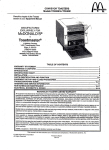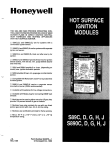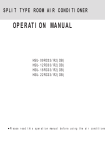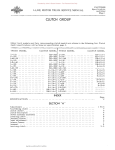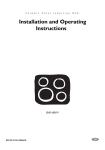Download Briggs & Stratton 20288 Owner`s manual
Transcript
OWNER'S MANUAL I . . ILMSBRUCTIOFIIS A. C. GENERATORS 8 Model 700 Series Model 1800 Series I Model 3030 Series :.- I I MODEL 1800 MODEL 700 If any correspondence is required regarding these generators, always be sure to furnish the model number and serial number stqmped on the generator nameplate. WINCHARGER CORPORATION SIOUX CITY 2, IOWA, U. S. A. Form SR214, Part No. 20757 I I I 1 INSTALLATION A N D OPERATION INSTRUCTIONS FOR W l N C O A.C. GENERATORS Model 700 Series Model 1800 Series Model 3030 Series MODEL WATTAGE SPEED ENGINE 700-11 700-12 700-13 700-14 700-1 700-2 700-3 700-4 500 500 500 500 700 700 700 700 3600 3600 3600 3600 3460 3460 3460 3460 1.04 1.04 1.04 1.04 Briggs & Sir. Clinton Continental Lauson 1800-11 1800-12 1800-13 1800-14 1800-15 1800-1 1800-2 1800-3 1800-4 1800-5 1000 1250 1350 1250 1350 1800 1800 1800 1800 1800 3600 3600 3600 3600 3600 3460 3460 2975 3460 2975 1.04 1.04 1.21 1.04 1.21 Briggs&Str. 8 2.5 Clipton D-1100 3.1 Cushman M6 3.0 Lauson T L W 3.0 Wisconsin ABN 4.6 3030-11 3030-12 3030-X 3030-X 2000 2000 3000 3000 3600 3600 2975 2975 1.21 1.21 B r i g g s & Str. Briggs&Str. 6 B700 AU7B RHS " 2.0 2.0 2.0 2.n 14 5.1 23 8.3 *Nominal wattage is at 1.0 Power Factor. All. units are rated at 115 volts, single phase, 60 cycles per second. The voltage varies with the speed at which the generator is driven and on the load being used. The generators only for above units are referred to as Model 700-0, 1800-0, and 3030-0 respectively. In the instructions all Model 1800's are referred to as 1000 watt. Models 3030A and 303OB are for tractor belt drive-generator specifications are same as for 3030-X. WINCHARGER CORPORATION Sioux City 2, Iowa, U. S. A. TABLE O F CONTENTS I. INTRODUCTION 4 A. Testing B. Unpacking C. Guarantee 11. INSTALLATION -------------- ........................ 4 A. Portable Use B. Transfer Switch C. Flexible Cord 111. F R A M E S - - - - - - - - - - - - - - - - - - - - - - - - - - - - - - - - - - - - - - - - 5 A. 500-1000 Watt Models 1. Engine Base Holes 2. Mounting 3. Belt Tightening 4. Checking Lineup B. 2000 Watt Models 1. Pulleys 2. Mounting 3. Belt Tightening 4. Checking Lineup IV. GENERATORS ........................................ A. B. C. D. 6 Design Performance characteristics Speed Overload Protection V. E N G I N E S - - - - - - - - - - - - - - - - - - - - - - - - - - - - - - - - - - - - - - - - 7 A. Lubrication B. Manuals VI. POWER REQUIREMENTS.............................. 7 A. Engine Size B. Altitude-Temperature VII. USE OF A.C. MOTORS ................................. 7 VIII. MAINTENANCE ....................................... 8 X. PARTS LIST ........................................... 10 XI. TRACTOR DRIVEN UNITS ............................. 10 XII. ACCESSORIES 12 Models 700, 1800,3030 8. INTRODUCTION etc. directly into the outlet terminals. The Each generator is carefully inspected at outlet box is equipped with lock-type rethe factory and "run-in" until the brushes ceptacles which prevent the plugs from are satisfactorily seated. The unit is then working loose. To operate permanently c o n n e c t e ~ carefully checked for correct output under average operating conditions. NO GENER- motors, etc. on a standby basis, provision ATOR IS SHIPPED UNLESS IT PRO- must be made to prevent the generated DUCES ITS FULL RA'IYCD CAPACITY, current from "feeding back" into the power NOR UNTIL IT HAS PASSED RIGID IN- line where it could be a hazard to linemen other users. SPECTION TESTS. If uwon installation a and ALL WIRING IS TO BE DONE IN CONnew generator does noi work properly, FORMANCE WITH -NATIONAL ELECcheck all of the electrical connections and TRICAL CODE AND WITH STATE AND the generator speed before concluding that LOCAL REGULATIONS. the generator is not performing satisfactThe conductor from the transfer switch orily. to the generator can be made of No. 14 type w h e n unpacking the machine, be sure to S cord for distance up to 25 feet. Always inspect it carefully to see that no damages use the twist-lock plug for making these occilrred in transit. If damages are noted, connections permanently. notify the transportation company imWhen starting the generator, turn off the mediately and have them write the load or reduce it. If too many light bulbs nature of the damages on the freight are left on, the generator may fail to build bill, so that a claim can be filed if necessary. up voltage. Each AC generator is guaranteed to be When a three pole double-throw switch free from defects in workmanship and is connected to a 115-230 volt system as material arising in connection with normal shown in Figure 1, the current from the usage for a period of one year, provided generator is available on both main that the owner returns his guarantee reg- branches. Any 220 volt appliances connectistration card within 10 days after pur- ed to the circuit will remain inoperative. chasing the unit. Fill in the information If the owner wants to use only part of the requested on the registration- card and electrical circuits, a two-pole, double throw return it, so the guarantee can be issued switch can be connected i n one or more to you. of the branch circuits as shown in Figure 2. So many different methods of wiring are encountered in the field that no specific II. INSTALLATION transfer switch recommendation can be given. However, a n electrician who thorwhen using the unit as a portable gen- oughly understands the problem should be erator, merely plug the power tools, lights, obtained to make the installation. - To Load I- ----- To Meter I (Neutral) II I_ I 7 I I Generator - . I I To Load ----I To Panel i I (Neutral) - I I I I L ----------1 Figure 2 + - To Generator Ill. FRAME All 500 watt and 1000 watt models have the necessary holes for mounting various types engines. Figure 3 shows the holes which are used for mounting the follow.ng types of engines: Holes Type Engine Briggs & Stratton No. 8 Briggs & Stratton No. 6 Continental 7B Clinton D-1100 (A base) Clinton B-700 (New base) Cushman M6 Lauson TLH Wisconsin ABN Lauson RSH Clinton D-1100 ( B base) Clinton B-700 (Old base) A A A B B C D E F G G D @ required. The belt should deflect about ?/4" when a pressure of 6 lbs is applied midway between the pulleys. After the proper position has been determined, install the three remaining bolts in the generator base and tighten securely. Then recheck the belt lineup using a straight edge across the beIt pulleys as shown in Figure 5. Finally replace the belt guard. 43 @ 0 0 80 63 a@O 0 a 2000 WATT MODELS 8 0 O @ 8 80 0 @@ @, oa Figure 3 Two sets of are drilled for mounting the generators on the cross members. The 500 watt units use the set of holes nearest the belt guard. To install the engine on these frames, proceed as follows: Remove the belt guard; mount. the engine in place and secure it rigidly with the four bolts furnished. Remove three of the bolts holding the generator to the frame, leaving only one of them in posilioil as shown in Figure 4. The generator can then be pivoted on the single bolt to install the belt. After the belt is put on the pulleys, pivot the generator so the generator shaft IS parallel to the cross braces. If it is found that the belt is too tight or too loose, the pivoting bolt should be loosened and the generator moved forward or backward as The V belt and two engine pulleys are furnished with units shipped without engines. One pulley has a %" bore, and the other 1" bore. Either ,one or the other pulley will fit practicafly all engines, but if it does not the pulley will have to be bored to suit or a bushing will have to be installed. To mount the engine on the frame proceed as follows: Loosen the bolts on the adjustable rails shown in Figure 6. Mount the engine with the four bolts furnished, leaving the nuts loose. Using a large screwdriver or small b 5 back to tighten the belt as shown in Figure 7. The belt should deflect about '/4" when the pressure of 7 lbs. is applied. midway between the pulleys. Recheck the lineup on the belt with the straight edge, as shown in Figure 5. If necessary, the pulley on the generator can be moved slightly to effect proper lineup. Be sure to tighten the Allen screw holding the generator pulley in place. Figure 9 V schematic diagram,. Figure 10. The drive pulley is on the commutator end and the AC box is on the opposite end. The proper direction of rotation is indicated by an arrow on the end of the generator. IV. GENERATORS DESIGN These generators are self-excited AC types with the commutator located at one end (See Figure 8) and the slip rings located a t the opposite end of the armature. (See Figure 9-The 500 watt and 2000 watt models do not have klixon shown). There are both a DC winding and an AC winding on the armature; the only purpose of the DC winding is to produce "direct" current to energize or excite the field coils-see Figure 10 Performance Characteristics Providing that constant generator speed is maintained, the output voltage remains reasonably constant from no load to full load. No rheostat is necessary to adju;' the voltage. The engine governor must be working properly to maintain reasonably constant voltage. When lights or appliances are turned on, the generator must produce more electric power. The engine must consequently supply more power to the generator. No engine maintains perfect speed regulation, particularly as it approaches a fully loaded condition. The generator speed must be 3600 revolutions per minute to produce 60 cycles per second at rated voltage. However, since there is a slight speed variation it is best to operate the unit at a slightly higher speed with no load connected. Then, as lights or appliances are used, without resetting .the engine throttle the output will be at, or perhaps slightly below, the specified voltage' and frequency. If necessary the throttle setting can be increased slightly if full rated output is desired continuously. If the engine governor is sluggish or does not work properly, its speed will decrease considerably when the electrical load is increased. The resulting decrease in generator speed may cause lights to be dim and appliances to be lacking in power. (See engine instructions regarding governor). On an average the frequency and voltage will drop approximately as shown in Figure 11 c;n these units when driven with engines normally supplied. Larger engines which maintain better speed control tend to maintain better voltage stability. V. ENGINES ENGINES ON AC GENERATORS ARE SHIPPED WITHOUT OIL. Be sure to fill the crankcase to the proper level and fill the gasoline tank before starting. See engine instruction book for grade and type of oil. Engine operating and maintenance manuals furnished by the engine manufacturer are supplied with all units shipped with engines. Be sure to follow these instructions. If the generator was obtained separately, also be sure to obtain the engine manual. In case of engine trouble contact engine manufacturer's local representatives for assistance or repair parts. V1. P O W E R REQUIREMENTS Speed The speed of the generator is extremely important and should never be below 3450 rpm. If the generator speed is too low, it will not produce its rated output and, if fully loaded, will heat excessively. If low voltage under load is encountered, be sure to check tine generator speed with an accurate tachometer before concluding that the generator is defective. The generators supplied with engines have the governor set to produce a generator speed of 3600 rpm at approximately 60% of rated output and should not be readjusted unless it is done with an ac:urate tachometer. Excessive speed not only produces added strain on generators, but abnormally high voltage also materially shortens the life of the elgctrical devices used. Even though generators may be equipped with klixon thermostatic overload switches or fuses, they can be overloaded if run at excessive swed. The maximum wattage for each of the units covered by this manual is given on Page 2. Engines of different manufacture and of larger capacity can be used, but the electric load should not exceed fhe maximum wattage shown for sustained operation. Smaller engines than shown on the table on Page 2 can be used for any model, but the electric load must be reduced proportionately. For example, on the 2000 watt mddels any engine from one H.P. can be used. Such engines, however, would not have adequate power to furnish the current required to start motors. (See "Use of AC Motors"). If the engine used to drive the generator does not have sufficient power to drive the generator in areas of high altitude and high temperature, it is important to remember that engines lose power at the rate of about 3% for each 1000 feet of altitude and 1% for each 10 degrees above 60 degrees Fahrenheit at sea level. In addition to this, a good quality fuel must be used to get the full rateh output from any engine. Most engine manufacturers recommend that the engine load should not exceed 85% of rated horsepower. VII. USE O F A.C. M O T O R S The maximum rated wattage of the generators for starting motors is given in the tabie on Page 2. For the same motor size, The 1000 watt models are equipped with split-phase motors such as are normally klixon thermostatic switches. If the switch used on washing machines, refrigerators, opens due to overload, the generator should etc., require more starting current than be allowed to cool for several minutes, and others such as capacitor-start and inducthe red button adjacent to the outlet box tion-repulsion types. In general the power pressed down. If the generator has been requirements for starting and running variallowed to cool sufficiently, the switch can ous sizes of electric motors is approximatebe snapped back in place, thus completing ly as follows: H.P. Running Starting the circuit. 1/8 200 l/6 300 900-1500 The 500 watt models are not equipped 1/4 400 1200-2000 with any type of overload protection. The 450 1350-2250 1/3 load line should be fused using fuses of 600 1800-3000 suitable type and capacity. Overload Protection The motor starting current is limited by the engine as well as the generator. It will be observed from the table that the 500 watt models are recommended for only small electric tools and appliances using universal type motors of 1/8 H.P. or less. The 1000 watt models, when equipped with an engine of adequate power, can be expected to start 1/6 H.P. motors and some 1/4 H. P. types. The 2000 watt models, when equipped with an engine of adequate size, will start electric motors up to and including 1/2 H.P. For maximum starting capacity larger motors such as the Briggs & Stratton Model 23 should be used. Motors usually have a power factor of approximately 70%. That is, a motor that uses 700 watts at 110 volts actually requires as much current (amperes) as 1000 watts (700 + .TO) of light bulbs or other loads with 100% power factor. This fact must be taken into consideration when considering the maximum motor load a generator will handle. VIII. MAINTENANCE A. BRUSHES Check the brushes every 500 hours of operation. They are easily removed by removing the brush holder caps. The spring and pigtail lead is supplied as an integral part of the brush. When the brushes have worn down to approximately '/z inch, they should be replaced. B. DISASSEMBLY These generators can easily be disassembled for inspection. (See Figure 8 and 9). Merely remove the "thru bolts" and tap the end castings outward, using a light hammer and chisel applied to a projecting part of the casting. the inner race. Never exert any pressure on the outer race when installing a bearing on the shaft. IX. LOCATING TROUBLE If the wiring and speed are correct ana the unit does not generate properly, first disconnect the load, then test the AC end, then the DC end and finally the armature. These step by step tests are given in the following paragraphs. A. A.C. END TESTS With the generator operating at 3600 rpm disconnect all external wiring by removing the plug or cap from the AC outlets. Use a voltmeter at the AC outlets to determine whether or not AC voltage is present under those conditions. (If no voltmeter is available, an ordinary 110 light bulb can be used with fair success). 1. If the correct voltage reading is obtained on open circuit, that is with all loads removed, the generator is very likely overloaded or there is a short in the external circuit. Decrease the load or locate and correct the short. 2. If low or no A C ~ o l t a g eis obtained at the outlet terminals, continue to run the generator on open circuit and check the AC voltage at the brushes. This can be done by unscrewing the brush caps onehalf way as shown in Figure 12, using a pair of sharp prods of the voltmeter to connect directly to the brush holders; about 120 volts should be obtained at this point with the generator running at normal speed. If the correct AC voltage is obtained a t the brushes but not at the AC outlets, thert must be an open circuit between the brushes and outlets. C. BEARINGS Ball bearings are standard equipment on all Winco AC generators and are packed with grease before assembling; no further greasing is required. If considerable play is present in the bearing, it should be replaced with a new one. Whenever removing old bearings from the shaft of a defective armature use a bearing puller. Failure to do so may result in completely ruining the bearing. Premature failure can be caused by running the drive belt too tightly. If new bearings are installed, be sure to press them against the shaft shoulder, so that when the armature is installed there is a small amount of end play. In installing new bearings, they should be pressed down with an arbor press or forced on by using a piece of pipe approximately the size of .- Figure 12 a. On 1000 watt models allow the generator to cool several minutes and push down on the red button. If the klixon had opened, this would again close the circuit and voltage should be available at the outlet terminals. (Some Model 1800s have automatic reset klixons which snap shut when the generator has cooled sufficiently). If an open circuit in the klixon is suspected, check with an ohmeter. the brush can be reached in order to force the brush down firmly against the commutator as shown in Figure 13. b. On 2000 watt models install a new fuse since the fuse may have blown. If an open circuit is detected between the A.C. brushes and outlets, but the overload protective device is satisfactory, cafefully examine all leads and connections. Correcting the open circuit should restore the unit to operation. B. D.C.END !IZSTS 1.. If no voltage is obtained at the AC brushes, check the DC end to make sure that the field coils are being energized. With the generator running at normal speed, unscrew one of the DC brush caps and allow the brush to move back and forth so that it makes and breaks contact with the commutator. If the DC part of the generator is working properly, some arcing or flashing will be obtained at the generator brush when the field circuit is broken; ,a few seconds of time must be allowed for the voltage to build up before repeating the test. In a darkened room this arcing can be seen by reflection through the bottom ventilation holes in the generator. If there is too much light present, use a mirror or look directly through the ventilation slots to determine whether or not arcing is produced when a brush is lifted. A slight difference in the tone of the generator will also be observed as the generator is allowed to build up a voltage if the DC part of it is working correctly. 2. If the generator builds up a satisfactory DC voltage but no AC voltage is produced, very likely there is a defect in the winding on the armature. Have it checked at a generator repair shop. 3. If the DC end 'is'found not to be working properly, proceed as follows: a. If new DC brushes have been'installed, perhaps they are not seated properly. Remove the brush caps and insert a small stick of wqod or plastic through the brush springs, so that the top of After running a few minutes if the generator builds up voltage, put the brush caps back in the proper position and the generator should work properly. b. If the DC brushes have been properly seated, it is possible that they are sticking. Remove them from the brush holder and examine the holders for roughness or binding. Although it is improbable that the brushes will stick because of being oversize, a small amount can be filed off the edges if it is found that they are sticking in the brush holders. c. If the brushes are found to be making satisfactory contact .,with the armature but no DC voltage is built up to energize the field coils, stop the generator and check the field circuit with a test light. This test light consists of two insulated test prods, a male plug, and a light bulb connected as shown in ~ i g & e 14. CAUTION: BE CAREFUL NOTTOTOUCHTHECONDUCTORS AT THE END OF THE PRODS SINCE THEY ARE CONNECTED TO THE POWER LINE. WHEN USING THE TEST LIGHT ON ANY EQUIPMENT. ALWAYS MOUNT IT O~ A WELL: INSULATED BASE SUCH AS DRY WOOD, GLASS, OR RUBBER. DO NOT TOUCH THE OBJECT WHILE IT IS BEING SUBJECTED TO TEST. Insulated Test Prods To A.C. Power Lines Figure 14 Bulb d. To test .the field circuit proceed as follows: Remove the brush holder caps and brushes. Connect one test prod to the metallic part of the brush holder. Similarly connect the other test prod to the other brush holder. If the bulb lights, the field coils a r e probably o. k. If the bulb does not light, there is an oper, circuit in the field. Disassemble the generator and check the connection where the two coils are connected together. Tighten or resolder any connections which are found loose. If no open circuit is present, check them for grounds by touching one test prod to the metallic part of the brush holder and the other part to the generator frame. The test bulb should not light. If it does, there is a short be- X. tween these two parts. Examine the brush holder-usually causes of shorts in this part of the circuit are readily apparent, and the difficulty can be easily corrected by cleaning out the foreign material, such as carbon, grease, dirt, etc., or by taping the shorting parts or repositioning the field coil terminals. C. ARMATURE If no troubles can be located in either the AC end or DC end, very likely there is a defect in the windings of the armature. To test the armature special equipment is required; this should be done in a generator service shop. PARTS LIST FOR W l N C O A.C. GENERATORS MODEL 700, MODEL 1800, and MODEL 3030 SERIES Model Engine Type Model No. Without Engine Engine Pulley Engine Pulley Key Belt *3030-X *3030-X. 20247 20247 20299 20299 20563 20563 Briggs & Stratton $6 Clinton B-700 Continental 7-B Lauson RSH Briggs & Stratton $8 Clinton D-1100 Cushman M-6 Lauson TLH Wisconsin ABN 3030-11 3030-12 Briggs & Stratton $14 Briggs & Stratton $23 *20284 Pulley is also supplied with model 3030-X and 3100-X ' Model 700 20266 20268(set) Model 1800 20290 20260 20260-1 Model 3030 20585 20590 20590-1 Description Armature Top Field Coil Bottom Field Coil SLIP-RING END (A.C. OUTLET END) PARTS 5367 5065 8645 6383 6211 7227 6532 7924 *20510 "25099 *20509 6383 6211 7227 6532 7924 9775 20510 25099 20509 6383 6211 7227 6532 7924 A.C. Brush (2 req'd) Brush Holder Cap Brush Holder Brush Holder Set Screw Bearing Oil Slinger Shim Fan Baffle ------Iflixon Thermo Switch .... ------20577 Fuse Fustron 9706 9706 9706 Twist Lock Receptacle 20511 20511 20511 Twist Lock Cap ------4667 Fuse Receptacle " ------9978 Voltmeter ------20574 Voltmeter Receptacle 8617-1 8617 20582 End Bracket *Model 1800 with serial numbers below 1360 uses same brushes, brush holders, and caps a s Model 700. - - D.C. END (PULLEY END) PARTS 7978 7978 D.C. Brushes (2 req'd) 7948 7948 Brush Holder Cap 7944 7944 Brush Holder Assy. 6383 6383 Brush Holder Set Screw 4783 4783 Bearing 20410 20410 ,_ Oil Slinger [email protected] 4- - A l ? y ~ n dBracket 20288 20288 Gen. Pulley 20287 20287 Gen. Pulley Key 20330 20539 Belt Guard _ MISCELLANEOUS PARTS 20305 20305 20570 Frame and Feet Assy. 20191 20191 20191 Rubber Foot 20235-1 20250-1 20600-1 Generator, less pulley .Engine parts are available from engine manufacturer's local dealer or distributor. 11 XI. TRACTOR DRIVEN UNITS Model 3030A anu 3030B, shown in Figure 15, use the same generator as other 2000 watt models described in this booklet. The model 3030A has a 4" diameter flat drive pulley (Part No. 9974) for a belt speed of 1885 feet per minute. The model 3030B is the same except it has a 5%" diameter pulley (Part No. 9975) for a belt speed of 2590 feet per minute. Any flat belt from 335" to 6" wide t a n be used. The counter shaft is mounted on two No. 9948 Pillow Block bearings and runs at 1800 R.P.M. The counter shaft V pull; (Part No. 9743) is used to give a 2:l rat. to the generator speed. This unit uses V. Belt No. 9741 and Generator Pulley No. 20288. Figure 15 A. SPEEDY SHIFT BASE B. VOLTMETER All models described in this booklet deA plug-in type voltmeter, Figure 17, is signed for mounting the engine directly. on supplied on Model 3030. It can be plugged the frame can be quickly converted to por- into the outlet box or into a regular wirtable use by the use of a "Speedy Shift" at- ing outlet to maintain a close check on the tachment. This consists of wheels, axle, sup- voltage. It can also be supplied as an acport brackets, handle, and the necessary cessory on other models (Part No. 9978). bolts, etc. Figure 16 qhows how the parts are attached. The engine and generator have been removed to show attachment details. The dealer from whom you purchased the unit can supply' the accessory.













